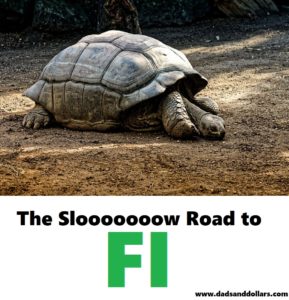“I know where I’m going. Where I’ve always been going. Home. The long way around.”*
If you pay attention to the FIRE** blogging community for more than, oh, I don’t know, ten seconds, you know that there are a whole lot of people who are bent on retiring well before standard retirement age. Many of them want to retire before 40. Some are even aiming for before age 30.
But is that the best way for everyone? Do I need to make that my highest priority, giving up everything else to get there as quickly as I can?
Of course I don’t.
And so, apparently, I’ve become part of the Slow FI movement, if that’s a thing.
Or have I?

The Eleventh Doctor was going home the long way around, too…did he subscribe to Slow FI?
Okay, what’s Slow FI?
The moniker “Slow FI” was introduced by Jessica at The Fioneers, who defined the term very succinctly:
Slow FI: When someone utilizes the incremental financial freedom they gain along the journey to financial independence to live happier and healthier lives, do better work, and build strong relationships.
Sounds good so far. It fits with what it says I’m doing at the top of this page: “starting a long journey to reach FIRE, contentment, or both.” Slow FI is a long journey, right? Of course it is.
You don’t have to look very far to find articles explaining why Slow FI is a better option for some people.

What’s involved
It’s pretty simple, really: not everyone wants to (or is able to) save 90% of their income while giving up everything that even remotely resembles fun. This article talks of people who gave up attending friends’ weddings and date nights, among other things. If one is pursuing Slow FI, one takes a more moderated approach to what one is going to sacrifice.
(I should probably add, as an aside, that when I have seen people take the full-throttle, non-Slow FI approach, they almost always don’t have kids.*** Very obviously, that is not the case for me.)
Zach at Four Pillar Freedom put it very nicely:
Slow FI emphasizes a simple tradeoff: A longer path to F.I. in exchange for a more enjoyable path to F.I.
We have made the decision that we want to have experiences with our children that they will remember. This could be as big as a trip to Disneyland or as small as a trip to Dutch Bros. (It’s way better than Starbucks, IMO.) No, we don’t do either of those very often.
Of course, there are also necessities that arise when one has children. They insist on being clothed (and we insist on it when the youngest doesn’t), for example, so we keep buying clothes with the money we might otherwise be saving for retirement.
Anyway, our situation, with the clothes and, yes, the coffee, all adds up to not being able to save anywhere close to the percentage that would be required for me to retire anytime soon.
I guess you might say I subscribe to Slow FI, then.
But I’d disagree.
So why doesn’t that apply to me?
There’s a very good reason why I don’t think of myself as being on a Slow FI path: It feels as though I’m not making any progress at all.
That’s not Slow FI, that’s No-FI.
I don’t need to go into my situation again…it’s been covered here, mostly. But as it stands now, we’re going to finish 2019 with credit card debt for the first time in years. (That’ll really help my standing with the personal finance community!)
One thing I will take from the Slow FI idea, though, is that I’m (hopefully) not going to stress out about my situation.
How about you? If you are on the journey to financial independence, are you enjoying the ride?
* The Eleventh Doctor, The Day of the Doctor
** Financial Independence, Retire Early. But you knew that.
*** Maybe there are families with kids who are chasing FIRE at breakneck speed. I just haven’t encountered any.
Note: this post may contain affiliate links. And honestly, it probably does. View my affiliate link disclaimer here.
You have solid priorities, I’m so sorry you’ve got so many family health issues. No advice, but thoughts and prayers that things will get better. There is a lot written about avoiding unnecessary expenses but there is very little written about enormous unavoidable costs that are a reality for many families.